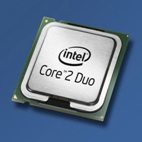Central processing unit (CPU)
 The CPU acts as the brain of the computer. Its function is to execute program
instructions and coordinate the activities of all the other units. It is built
into a single chip, a small piece of silicon with a complex electrical circuit
called an integrated circuit.
The CPU acts as the brain of the computer. Its function is to execute program
instructions and coordinate the activities of all the other units. It is built
into a single chip, a small piece of silicon with a complex electrical circuit
called an integrated circuit.
The CPU consists of three main parts:
-
The control unit
Řídící jednotka = A part of the CPU which coordinates all the other parts of the computer system
examines the instructions in the user’s program,
interprets each instruction and causes the rest of the components to
execute the functions specified.
-
The arithmetic logic unit (ALU)
Aritmeticko-logická jednotka = A part of the CPU which performs the actual arithmetic and logical operations asked for by a program
consists of a series of special registers
and circuits which are able to perform the operations of addition, subtraction,
multiplication, division, comparison, data shifting, etc. The ALU can distinguish
positive, negative, and zero values, perform calculations, make logical decisions,
and transfer the results to other units of the computer.
-
The registers are high speed units of memory used to store and control data.

 The CPU acts as the brain of the computer. Its function is to execute program
instructions and coordinate the activities of all the other units. It is built
into a single chip, a small piece of silicon with a complex electrical circuit
called an integrated circuit.
The CPU acts as the brain of the computer. Its function is to execute program
instructions and coordinate the activities of all the other units. It is built
into a single chip, a small piece of silicon with a complex electrical circuit
called an integrated circuit.